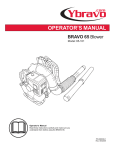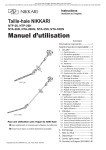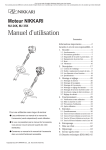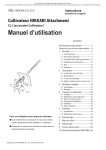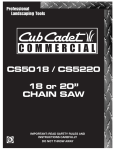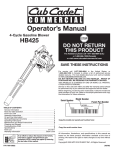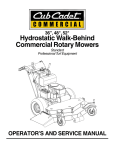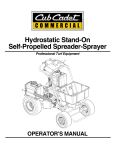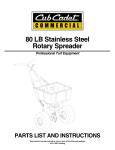Download Cub Cadet BB40 Specifications
Transcript
Professional Landscaping Tools BB40 BACK PACK BLOWER IMPORTANT: READ SAFETY RULES AND INSTRUCTIONS CAREFULLY DO NOT THROW AWAY Table of Contents Content Page Introduction . . . . . . . . . . . . . . . . . . . . . . . . . . . . . . . . . . . . . . . . . . . . . . . . . . . . . . . . . . . . . . . 2 Safety . . . . . . . . . . . . . . . . . . . . . . . . . . . . . . . . . . . . . . . . . . . . . . . . . . . . . . . . . . . . . . . . . . . 3 Know Your Unit . . . . . . . . . . . . . . . . . . . . . . . . . . . . . . . . . . . . . . . . . . . . . . . . . . . . . . . . . . . . 7 Assembly . . . . . . . . . . . . . . . . . . . . . . . . . . . . . . . . . . . . . . . . . . . . . . . . . . . . . . . . . . . . . . . . . 8 Oil & Fuel . . . . . . . . . . . . . . . . . . . . . . . . . . . . . . . . . . . . . . . . . . . . . . . . . . . . . . . . . . . . . . . . . 9 Operation . . . . . . . . . . . . . . . . . . . . . . . . . . . . . . . . . . . . . . . . . . . . . . . . . . . . . . . . . . . . . . . . 10 Maintenance. . . . . . . . . . . . . . . . . . . . . . . . . . . . . . . . . . . . . . . . . . . . . . . . . . . . . . . . . . . . . . 12 Specifications . . . . . . . . . . . . . . . . . . . . . . . . . . . . . . . . . . . . . . . . . . . . . . . . . . . . . . . . . . . . 15 Warranty . . . . . . . . . . . . . . . . . . . . . . . . . . . . . . . . . . . . . . . . . . . . . . . . . . . . . . . . . . . . . . . . . 16 To the Owner Thank you for buying this quality product. Before starting or operating this equipment, read the whole manual and follow all the instructions to keep your new outdoor power tool in top operating condition. All information, illustrations and specifications in this manual are based on the latest product information available at the time of printing. We reserve the right to make changes at any time without notice. Service on this unit both within and after the warranty period should be performed only by a Cub Cadet Commercial dealer. Proof of purchase will be required for warranty service. Spark Arrestor NOTE: For users on U.S. Forest Land and in the states of California, Maine, Oregon and Washington. All U.S. Forest Land and the state of California (Public Resources Codes 4442 and 4443), Oregon and Washington require, by law that certain internal combustion engines operated on forest brush and/or grass-covered areas be equipped with a spark arrestor, maintained in effective working order, or the engine be constructed, equipped and maintained for the prevention of fire. Check with your state or local authorities for regulations pertaining to these requirements. Failure to follow these requirements could subject you to liability or a fine. This unit is factory equipped with a spark arrestor. If it requires replacement, Spark Arrestor Screen is available by contacting the service department. Emission Control Information This engine is certified to operate on unleaded regular grade gasoline only. A minimum of 87 octane of the antiknock index is recommended. The antiknock index is posted on service station pumps in the United State. To protect the environment, this unit has an exhaust emission control system (EM) in compliance with applicable regulations of the California Air Resources Board. The exhaust emission control system applied to this engine consists of a carburetor and an ignition system with optimum ignition timing characteristics. Carburetors have been calibrated to provide lean air/fuel mixture characteristics and optimum fuel economy with a suitable air cleaner and exhaust system. Proper maintenance is required to ensure low emission levels for your engine. This manual contains maintenance recommendations, outlined by the periodic maintenance chart. Follow items in this chart to ensure compliance with the applicable standards. The Limited Emission Control System Warranty requires that you return your engine to an authorized engine dealer for remedy under warranty. Please read the warranty carefully and keep it valid by complying with the list of owner’s obligations that it contains. Federal law and California state law prohibits the following acts or the causing thereof: •The removal or rendering inoperative by any person other than for purposes of maintenance, repair, or replacement of any device or element of design incorporated into any new engine for the purposes of emission control prior to its ale or delivery to the ultimate purchaser or while it is in use, or • The use of the engine after such device or element of design has been removed or rendered inoperative by any person. Among those acts presumed to constitute tampering are the acts listed below (do not tamper with the original emission-related parts): Carburetor and internal parts, Spark plug, Magneto or electronic ignition system, Fuel filter, Air cleaner element Calling Customer Support If you have difficulty assembling this product or have any questions regarding the controls, operation or maintenance of this unit, please call the Customer Support Department. Call 1-877-282-8684 to reach a Customer Support representative. Please have your unit’s model number and serial number ready when you call. See the previous section to locate this information. Copyright© 2003 Cub Cadet Commercial LLC All Rights Reserved For more details about your unit, visit our website at www.cubcadetcommercial.com 2 Section 1 Safety The purpose of safety symbols is to attract your attention to possible dangers. The safety symbols, and their explanations, deserve your careful attention and understanding. The safety warnings do not by themselves eliminate any danger. The instructions or warnings they give are not substitutes for proper accident prevention measures. SYMBOL MEANING SAFETY ALERT SYMBOL: Indicates danger, warning or caution. Attention is required in order to avoid serious personal injury. May be used in conjunction with other symbols or pictographs. NOTE: Advises you of information or instructions vital to the operation or maintenance of the equipment. Failure to obey a safety warning will result in serious injury to yourself or to others. Always follow the safety precautions to reduce the risk of fire, electric shock, and personal injury. Failure to obey a safety warning can result in injury to yourself and others. Always follow the safety precautions to reduce the risk of fire, electric shock, and personal injury. California Proposition 65 Warning THE ENGINE EXHAUST FROM THIS PRODUCT CONTAINS CHEMICALS KNOWN TO THE STATE OF CALIFORNIA TO CAUSE CANCER, BIRTH DEFECTS OR OTHER REPRODUCTIVE HARM. Failure to obey a safety warning may result in property damage or personal injury to yourself or to others. Always follow the safety precautions to reduce the risk of fire, electric shock, and personal injury. Important Safety Instructions READ ALL INSTRUCTIONS Before Operating • Clear the area of children, bystanders, and pets. At a minimum, keep all children, bystanders, and pets outside a 50 feet (15 m.) radius; there still may be a risk to bystanders from thrown objects. Bystanders should be encouraged to wear eye protection. If you are approached, stop the unit immediately. When using the unit, you must follow the safety rules. Please read these instructions before operating the unit in order to ensure the safety of the operator and any bystanders. Please keep these instructions for later use. Safety Warnings for Gas Units • Read the instructions carefully. Be familiar with the controls and proper use of the unit. Gasoline is highly flammable, and its vapors can explode if ignited. Take the following precautions. • Do not operate this unit when tired, ill or under the influence of alcohol, drugs or medication. • Children and teens under the age of 15 must not use the unit, except for teens guided by an adult. • Store fuel only in containers specifically designed and approved for the storage of such materials. They should have an anti-spill valve. • Inspect the unit before use. Replace damaged parts. Check for fuel leaks. Make sure all fasteners are in place and secure. Replace parts that are cracked, chipped or damaged in any way. Check that the spark plug and other items are not damaged. • Always stop the engine and allow it to cool before filling the fuel tank. Never remove the cap of the fuel tank, or add fuel, when the engine is hot. Never operate the unit without the fuel cap securely in place. Loosen the fuel tank cap slowly to relieve any pressure in the tank. • Carefully inspect the area before starting the unit. Remove all hard or sharp objects such as glass, wire, etc. • Avoid creating a source of ignition for spilled fuel. Do not start the engine until fuel vapors dissipate. 3 Safety (continued) • Add fuel in a clean, well-ventilated outdoor area where there are no sparks or flames. Slowly remove the fuel cap only after stopping engine. Do not smoke while fueling or mixing fuel. Wipe up any spilled fuel from the unit immediately. • Do not operate the engine faster than the speed needed to do the job. Do not run the engine at high speed when not in use. • Move the unit at least 50 feet (15 m) from the fueling source and site before starting the engine. Do not smoke. Keep sparks and open flames away from the area while adding fuel or operating the unit. • Stop the engine for maintenance or repair. The unit must be stopped and the impeller no longer turning to avoid contact with the rotating blades. • Never fill with fuel while the engine is running. While Operating • Never start or run the unit inside a closed room or building. Breathing exhaust fumes can kill. Operate this unit only in a well ventilated outdoor area. • Wear safety glasses or goggles that are marked as meeting ANSI Z87.1-1989 standards. Also wear ear/hearing protection when operating this unit. Wear a face or dust mask if the operation is dusty. Long sleeve shirts are recommended. • Wear heavy, long pants, boots or safety footwear and protective gloves. Do not wear loose clothing, jewelry, short pants, sandals or go barefoot. Secure hair above shoulder level. • To reduce the risk of hearing loss associated with sound level(s), always wear ear/hearing protection when operating this unit. • Use the unit only in daylight or good artificial light. • Avoid accidental starting. Be in the starting position whenever pulling the starter rope. The operator and unit must be in a stable position while starting. See Starting/Stopping Instructions. • Do not set unit on any surface except a clean, hard area while engine is running. Debris such as gravel, sand, dust, grass, etc. could be picked up by the air intake and thrown out by the discharge opening, damaging unit, property, or causing serious injury to bystanders or operator. • Use the right tool. Only use this tool for the purpose intended. • Do not force unit. It will do the job better and with less likelihood of injury at a rate for which it was designed. • Do not overreach or use from unstable surfaces such as ladders, trees, steep slopes, rooftops, etc. Always keep proper footing and balance. • Always hold the unit with a firm grip when operating. • Keep hands, face, and feet at a distance from all moving parts. Do not touch or try to stop the impeller when it is rotating. Do not operate without guards in place. • Do not put any object into openings. Do not use with any opening blocked; keep free of dirt, debris, and anything that may reduce the air flow. • Do not touch the engine or muffler. These parts get extremely hot from operation. When turned off they remain hot for a short time. 4 • Always stop the engine when operation is delayed or when walking from one location to another. • Use only original equipment manufacturer replacement parts when servicing this unit. These parts are available from your authorized service dealer. Do not use unauthorized parts, accessories, or attachments for this unit. Doing so could lead to serious injury to the user, or damage to the unit, and void your warranty. • Never use this unit for spreading chemicals, fertilizers or other substances which may contain toxic materials. • To reduce fire hazard, replace faulty muffler and spark arrestor, keep the engine and muffler free from grass, leaves, excessive grease or carbon build up. • Never point the blower in the direction of people or pets, or in the direction of windows. Always direct the blowing debris away from people, animals, and windows. Use extra caution when blowing debris near solid objects such as trees, automobiles, walls, etc. Other Safety Warnings • Always disconnect the spark plug before performing maintenance or accessing movable parts. • Never store the unit, with fuel in the tank, inside a building where fumes may reach an open flame (pilot lights, etc.) or sparks (switches, electrical motors, etc.). • Allow the engine to cool before storing or transporting. Be sure to secure the unit while transporting. • Store the unit in a dry place, either locked up or up high to prevent unauthorized use or damage. Keep out of the reach of children. • Never douse or squirt the unit with water or any other liquid. Keep handles dry, clean, and free from debris. Clean after each use, see Cleaning and Storage instructions. • Keep these instructions. Refer to them often and use them to instruct other users. If you loan this unit to others, also loan these instructions to them. SPECIAL NOTE: Exposure to vibrations through prolonged use of gasoline powered hand tools could cause blood vessel or nerve damage in the fingers, hands, and joints of people prone to circulation disorders or abnormal swelling. Prolonged use in cold weather has been linked to blood vessel damage in otherwise healthy people. If symptoms occur such as numbness, pain, loss of strength, change in skin color or texture, or loss of feeling in the fingers, hands or joints, discontinue use of this tool and seek medical attention. An anti-vibration system does not guarantee avoidance of these problems. Users who operate power tools on a regular basis must closely monitor their physical condition and the condition of this tool. SAVE THESE INSTRUCTIONS Safety (continued) PROTECTIVE SAFETY EQUIPMENT The Unit’s Protective Safety Equipment Personal Equipment Stop Switch- Use the stop switch to stop the engine. To service and test the stop switch, start the engine and make sure that the engine halts when you move the stop switch to the off position. Ear Protection- Wear ear protection that offers a sufficient dampening effect. Remove your hearing protection as soon as you stop the engine, in order to hear any noises or warning signals. Eye Protection- Wear safety glasses or goggles that are marked as meeting ANSI Z87.1-1989 standards to protect from blows to the eyes from branches or flying objects. Boots- Wear anti-slip and stable boots. Clothing- Wear clothes made of strong fabrics. Avoid loose clothing that could catch on shrubs and branches. Wear heavy long pants and do not wear jewelry, shorts, sandals or go barefoot. Secure hair above shoulder length. First Aid Kit- Always have a first aid kit present. Breathing Protection- Wear a dust mask if you are working in dusty conditions. Vibration Damping SystemThis is designed to make usage as vibration-free and comfortable as possible. The vibration damping system reduces the transfer of vibrations. Check the system often for cracks and distortion, and make sure it is securely attached. Muffler- The muffler reduces noise levels and directs the engine’s exhaust fumes away from the operator. Never use a unit that has a defective muffler and check to see that the muffler is secure. Clean the muffler’s spark arrestor screen regularly. Never use a muffler that has a defective spark arrestor screen. Refer to the Muffler section in the Maintenance chapter for more information. Safety Harness- A well-adjusted harness considerably simplifies your work. Adjust the harness to provide you with the most efficient stance. Adjust the side straps to equally distribute the weight of the unit across both of your shoulders. Never use a unit that has defective safety equipment. Maintain the safety equipment as described. If the safety equipment and/or the unit is defective or fails your control tests, contact your local service workshop. Never use the unit without the safety harness in tact. Failure to use the harness will make the unit less safe and increase the risk of injury to yourself or others. Never use a harness that has a faulty quick release. 5 Safety (continued) Safety and International Symbols This operator's manual describes safety and international symbols and pictographs that may appear on this product. Read the operator's manual for complete safety, assembly, operating and maintenance and repair information. SYMBOL MEANING • SAFETY ALERT SYMBOL Indicates danger, warning, or caution. May be used in conjunction with other symbols or pictographs. • WARNING - READ OPERATOR'S MANUAL Read the Operator’s Manual(s) and follow all warnings and safety instructions. Failure to do so can result in serious injury to the operator and/or bystanders. SYMBOL MEANING • KEEP BYSTANDERS AWAY WARNING: Keep all bystanders, especially children and pets, at least 50 feet (15 m.) from the operating area. • ON/OFF STOP CONTROL ON / START / RUN • ON/OFF STOP CONTROL OFF or STOP • WEAR EYE AND HEARING PROTECTION WARNING: Thrown objects and loud noise can cause severe eye injury and hearing loss. Wear eye protection meeting ANSI Z87.11989 standards and ear protection when operating this unit. Use a full face shield when needed. The following symbols/decals refer to certain certification requirements in certain markets: • Carry out maintenance and performance checks when the engine is switched off, with the stop switch in the Stop position. • CE This product is in accordance with applicable CE directives. • Always wear approved protective gloves. • WEAR APPROVED PROTECTIVE GLOVES • Regular cleaning is required. • Ocular control. • USE ANTI-SLIP, STABLE BOOTS • THROWN OBJECTS & ROTATING IMPELLOR BLADE CAN CAUSE INJURY WARNING: Keep clear of blower outlet. Never point the blower at yourself or others. Objects can be thrown from blower. Do not operate unit without proper attachments and guards in place. 6 • Approved eye protection must always be used. Wear eye protection meeting ANSI Z87.11989 standards. Section 2 Know Your Unit 12 1 11 2 10 3 9 4 8 7 6 5 Blower Components 1 - Spark plug 2 - Choke 3 - Starter handle 4 - Muffler 5 - Fuel tank 6 - Fuel cap 7 - Stop switch 8 - Throttle lever / control 9 - Blow tube 10 - Nozzle 11 - Air filter 12 - Shoulder Harness 7 Section 3 Assembly Instructions F A C B E D Assembling the Blower Carton Contents F - Engine Assembly Unpacking 1 - Hose Clamp with Screw (2) Your unit was carefully packed at the factory to prevent damage during shipment. Unpack the carton carefully: 1. Remove all contents from the carton. 2 - Flexible Tube 3 - Base Tube 4 - Middle Tube 2. Identify parts and check them with the list of parts in the above Carton Contents section. 5 - Bent Tube / Nozzle 3. Examine parts for damage. 4. Immediately notify your dealer if a part is missing or damaged. 1 2 Tube Assembly 1. Place a hose clamp on each end of the flexible tube (A). 3 2. Connect the flexible tube (A) to the fan’s outlet tube (B). 4 5 3. Slide the grooved end of the base tube (C) into the open end of the flexible tube and securely tighten the screws on the clamps. NOTE: The base tube is designed to swivel. This allows you to direct air flow. To avoid the tube slipping out, the base, middle and bent tubes must be tightly and perfectly inserted up to each stopper. 4. Install the middle tube (D) into the base tube, and install the bent tube / nozzle (E) into the middle tube. 5. Adjust the shoulder strap to fit your body comfortably. 8 Section 4 Oil and Fuel NOTE: This unit is equipped with a 2-stroke engine that must always run on a mixture of gas and oil. It is important to measure the quantity accurately, to ensure the correct mixing ratio. Small discrepancies in the amount of oil have a great bearing on the fuel mix proportions when mixing a small amount of fuel. Oil and Fuel Mixing Instructions Old and/or improperly mixed fuel are the main reasons for the unit not running properly. Be sure to use fresh, clean unleaded fuel. Follow the instructions carefully for the proper fuel/oil mixture. Gas Information The lowest recommended octane rating is 87. If you run the engine with gas with a lower octane than 87, “knocking” can occur. This leads to an increase in engine temperature, which can result in a serious engine breakdown. When working at continuous high revs, a higher octane gasoline is recommended. Mixture/Fueling • Always mix fuel and oil in a clean container that is intended for fuel. • Always begin by filling the container with half the amount of fuel required. Then add the entire oil quantity. Mix (by shaking) the mixture, and then fill the container with the remaining amount of fuel. • Mix the fuel mixture carefully, before pouring it into the fuel tank. • Do not mix more than one month’s supply of fuel. • If you don’t use the unit for a long period of time, you must empty and clean the tank. • When fueling, be sure to clean around the fuel cap. Contamination in the tank can disrupt operations. • Ensure that fuel is mixed thoroughly by shaking the container before filling the unit’s fuel tank. 2-stroke Oil For best results, use 2-stroke oil that has been specifically produced for use in small engines. Mixing ratio is 1:50 (2%). Contact your dealer when selecting an oil. Mixing ratio is 1:33 (3%). Never use 2-stroke oil that is intended for water-cooled outboard motors (referred to as outboard motor oil). Never use oil intended for 4-stroke engines. Remove fuel cap slowly to avoid injury from fuel spray. Never operate the unit without the fuel cap securely in place. Add fuel in a clean, well ventilated outdoor area. Wipe up any spilled fuel immediately. Avoid creating a source of ignition for spilt fuel. Do not start the engine until fuel vapors dissipate. NOTE: Dispose of the old fuel/oil mix in accordance to Federal, State and Local regulations. Gasoline is extremely flammable. Ignited Vapors may explode. Always stop the engine and allow it to cool before filling the fuel tank. Do not smoke while filling the tank. Keep sparks and open flames at a distance from the area. 9 Section 5 Operation Starting Instructions Stop Switch 1. Mix gas with oil. Fill fuel tank with fuel/oil mixture. See Oil and Fuel Mixing Instructions. 2. Put the Stop Switch in the START position. 3. Place the choke lever up into the CHOKE/CLOSE position. 4. Fully press and release the primer bulb (air purge diaphragm) 10 times, slowly, until fuel is visible in the primer bulb. If you can’t see fuel in the bulb, press and release the bulb as many times as it takes before you can see fuel in it. The bulb doesn’t have to be completely filled. Close Open 4. Press the machine body against the ground using your left hand. Do not use your foot. This is the starting position. 5. Grip the starter handle, and slowly pull out the starter rope with your right hand until you feel some resistance. After you feel resistance, quickly and powerfully pull the starter cord. 6. As soon as the engine fires, reset the choke lever down into the OPEN position. Pull the cord until the engine starts. 7. When the engine starts, quickly move the throttle to the full throttle position. NOTE: Do not pull the starter rope out completely. Do not suddenly release the starter cord from the fully extended position. These actions could damage the unit. NOTE: Choking is unnecessary when starting a warm engine. Put the Stop Switch in the ON position, and leave the choke lever in the its original position. Pull the starter rope. Stopping Instructions 1. Allow the engine to cool down by idling. 2. Put the Stop Switch in the STOP (O) position. Operate this unit only in a well ventilated outdoor area. Carbon monoxide exhaust fumes can be lethal in a confined area. Using the Throttle Air jet speed is controlled with the throttle. Select the speed that best suits the application. You can set the throttle to the desired / required throttle position by moving the throttle lever up or down. Move it up to blow more air, and move it down to idle. Avoid accidental starting. Make sure you are in the starting position when pulling the starter rope. To avoid serious injury, the operator and unit must be in a stable position while starting. Blow Idle 10 Operation (continued) Holding the Blower/Vacuum Before operating the unit, stand in the operating position. Check for the following: • Operator is wearing proper clothing, such as boots, safety glasses or goggles, ear/hearing protection, gloves, long pants and long sleeve shirt • Operate power equipment only at reasonable hours— not early in the morning or late at night when people might be disturbed. Comply with times listed in local ordinances. Usual recommendations are 9:00 am to 5:00 pm, Monday through Saturday. • To reduce noise levels, limit the number of pieces of equipment used at any one time. • To reduce noise levels, operate power blowers at the lowest possible speed to do the job. To avoid serious personal injury, wear goggles or safety glasses at all times when operating this unit. Wear a face mask or dust mask in dusty locations. • Check your equipment before operation, especially the muffler, air intakes and air filters. • If the conditions are dusty, the operator is wearing a dust mask or face mask • In dusty conditions, slightly dampen surfaces or use a mister attachment when water is available. • The unit is in good working condition • Conserve water by using power blowers instead of hoses for many lawn and garden applications, including areas such as gutters, screens, patios, grills, porches, and gardens. • The tubes and guards are in place and secure To prevent serious personal injury or damage to the unit, make sure blower tubes or vacuum tubes and the vacuum bag are in place before you operate the unit. Operating Tips • Be sure the vacuum bag is zipped closed before operating the unit. • Assure the unit is not directed at anybody or any loose debris before starting the unit. • Use rakes and brooms to loosen debris before blowing. • Watch out for children, pets, open windows or freshly washed cars, and blow debris safely away. • Use the full blower nozzle extension so the air stream can work close to the ground. • Make sure the air intake is not blocked. A blocked intake will reduce the air blowing capacity and increase the engine’s temperature. • Do not operate the blower while standing on a ladder. • Clean up after using blowers and other equipment. Dispose of debris appropriately. • Verify that the unit is in good working condition. Make sure the tubes and guards are in place and secure. 1. Use the blower for trees, shrubs, flower beds and hard-to-clean areas. • Always hold the unit with both hands when operating. Keep a firm grip on both the front and rear handle or grips. • To reduce the risk of hearing loss associated with sound level(s), hearing protection is required. 2. Use the unit around buildings and for other normal cleaning procedures. 3. Use the blower around walls, overhangs, fences and screens. 11 Section 6 Maintenance To avoid serious personal injury, always turn your blower off and allow it to cool before you clean or service it. Always wear protective gloves during maintenance operations. Do not carry out maintenance when the engine is hot. Daily Maintenance Weekly Maintenance 1. Clean the unit’s exterior. 2. Check that the throttle control functions safely. 3. Check that the stop switch is functioning properly. 4. Clean the air filter. 5. Check that all the nuts and screws are tightened. 1 3 2 1. Check the starter, the starter rope/cord, and the return spring. 2. Make sure that the vibration damping elements are not damaged. 3. Clean the outside of the spark plug. Remove and check the electrode gap. Remove and check the electrode gap. Adjust the gap to 0.5 mm or change out the spark plug. 4. Clean the cooling fins on the flywheel. 5. Clean or replace the muffler’s spark arrest screen. 6. Clean the carburetor area. 7. Clean the cooling fins on the cylinder and check that the air intake in the starter unit is unblocked. 4 1 2 5 3 7 6 5 4 Monthly Maintenance 1 1. Clean the fuel tank. 2 3 2. Clean the carburetor and its surrounding area. 3. Clean the fan and its surrounding area. 4. Check the fuel filter and the fuel pipe. Replace them if necessary. 5. Check all cables and connections. 6 4 6. Change the spark plug. 7. Check and clean the muffler’s spark arrestor screen if necessary (this is not present on mufflers with catalytic converters). 12 5 7 Maintenance (continued) Muffler Only start and use the unit when it is completely constructed. If you use the unit without all its covers fitted, you risk serious personal injury. Carburetor The unit’s engine is broken in after it has run through 8-10 tanks of fuel. To ensure the engine’s peak performance, you should have your engine serviced by an authorized dealer after it has been broken in. The service technician uses a revolution counter to adjust the carburetor for optimum operating conditions. This will help the unit produce the least amount of emissions. Operation The carburetor governs engine speed, through the throttle. Air and fuel are mixed in the carburetor, and this mixture is adjustable. This adjustment must be accurate in order to take advantage of the engine’s optimal output. The carburetor should be set to adapt to local conditions, like altitude, climate, gas, and the type of 2-stroke oil used. Basic Setting The carburetor is configured at a basic setting at the factory, before it ships to the customer. This basic setting is richer than the optimal setting. You should keep the basic setting during the unit’s first working hours. Afterwards, the carburetor needs to be finely tuned by a skilled technician. NOTE: Some mufflers are fitted with a catalytic converter. Refer to the Specifications to determine whether your unit is fitted with a catalytic converter. The muffler is designed to dampen the noise level of the engine, and to direct exhaust fumes away from the user. Exhaust fumes are hot and contain sparks, which can result in fire if the fumes are directed towards dry material. To prevent this, some mufflers are equipped with a spark arrestor screen. If your unit has a spark arrestor screen, you must clean it regularly. Clean the screen with a wire brush. On mufflers without a catalytic converter, clean the screen weekly, or replace it. On mufflers configured with a catalytic converter, you should check and clean the spark arrestor screen monthly. if the screen is damaged, you must replace it. If the screen is blocked frequently, an impaired catalytic converter may be to blame. if this is the case, contact your local dealer to inspect the muffler. A blocked spark arrestor screen will cause the engine to overheat, possibly damaging the cylinder and piston. Fine Adjustment After the engine has been broken in, it should be finely adjusted by a qualified technician. First adjust the Ljet, then the idling T screw, and then the H-jet. Conditions Never operate a unit that has a defective muffler. Before making any adjustments, be sure the air filter is clean and the air filter cover is properly fitted. Any carburetor adjustment performed with a dirty air filter will result in a leaner mixture when compared with the engine performance once the air filter is cleaned. This can lead to serious engine damage. 13 Maintenance (continued) Cooling System Air Filter To maintain as low of an operating temperature as possible, the engine is equipped with a cooling system. The cooling system consists of: 1. An air intake on the starter unit. The air filter should be cleaned regularly to remove dust and dirt. This will help avoid: • Carburetor malfunction 2. Cooling fins on the flywheel. 3. Cooling fins on the cylinder. 4. A cylinder cover that leads cold air onto the cylinder. Using a brush, clean the cooling system at least once a week. In difficult conditions, clean it more regularly. Spark Plug The condition of the spark plug is affected by: • An incorrect carburetor setting • An incorrect fuel mixture (too much faulty oil) • A dirty air filter These factors can cause deposits on the spark plug electrode. This may result in a malfunction or starting difficulties. NOTE: If the unit is low on power, difficult to start, or runs poorly while idling, always check the spark plug first. If the spark plug is dirty, clean it and check that it has a 0.5 mm electrode gap. Change the spark plug after one month of operation, or earlier. NOTE: Always use the recommended type of spark plug. An incorrect spark plug can damage the cylinder and piston. 14 • Problems with starting • Unnecessary wear to engine parts. • Abnormal fuel consumption Clean the filter after every 25 hours of operation, or more regularly if operating conditions are excessively dusty. Cleaning the Air Filter Dismantle the air filter cover and remove the air filter. Wash the filter in clean, warm soapy water. Ensure that the filter is dry before you refit it. An air filter that has been used for a long period of time can never become completely clean. From time to time, it is necessary to replace the filter with a new one. You must always replace a damaged air filter. If you use your unit in dusty places, you should soak the air filter in oil. Oiling the Air Filter The air filter contains a solvent that enables the oil to spread evenly throughout the filter. Therefore, avoid skin contact with the filter. To apply oil, place the filter in a plastic bag and pour the oil over the filter. Knead the plastic bag to distribute the oil. Squeeze any excess oil out of the filter inside the plastic bag. Pour off the excess before you fit the filter into the unit. Never use common engine oil. This could drain through the filter quickly and collect in the bottom. Section 11 Specifications ENGINE* Engine Type ........................................................................................................................... Air-Cooled, 2-Cycle Cylinder Capacity ..................................................................................................................................... 40.2 cm3 Cylinder Bore............................................................................................................................................... 40 mm Stroke Length .............................................................................................................................................. 32 mm Idle Speed .............................................................................................................................................. 2,500 rpm Recommended Maximum Speed .......................................................................................................... 7,500 rpm Maximum Engine Output (according to ISO 8893) ..................................................................... 2 kW/7,500 r/min Ignition Type/Manufacturer ............................................................................................................... Electronic/ET Ignition Switch................................................................................................................................. Rocker Switch Spark Plug....................................................................................................................................... NGK BPMR7A Spark Plug Gap........................................................................................................................... 0.02 in. (0.5 mm) Lubrication .................................................................................................................................... Fuel/Oil Mixture Fuel/Oil Ratio ....................................................................................................................................................50:1 Carburetor/Manufacturer........................................................................................................ Membrane / Walbro Fuel Tank Capacity ....................................................................................................................................1.6 pints Catalytic Converter ............................................................................................................................................ No OTHER SPECIFICATIONS* Approximate Unit Weight (without fuel) ........................................................................................................... 8 Kg Noise pressure level (measured according to EN31806 and ISO 7917) ........................................................... 89 dB(A) Noise power level (measured according to EN 31806 and ISO 10884) ....................................................... 103.5 dB(A) Vibration levels on handles (measured according to EN 31806 and ISO 7916) Vibrations when idling ................................................................................................................. max of 1.2 m/s2 Vibrations at maximum speed..................................................................................................... max of 1.2 m/s2 *All specifications are based on the latest product information available at the time of printing. We reserve the right to make changes at any time without notice. 15 MANUFACTURER’S LIMITED WARRANTY FOR: The limited warranty set forth below is given by Cub Cadet Commercial LLC with respect to new merchandise purchased and used in the United States, its possessions and territories. Cub Cadet Commercial LLC warrants this product against defects in material and workmanship for a period of two (2) years commencing on the date of original purchase and will, at its option, repair or replace, free of charge, any part found to be defective in material or workmanship. This limited warranty shall only apply if this product has been operated and maintained in accordance with the Operator’s Manual furnished with the product, and has not been subject to misuse, abuse, commercial use, neglect, accident, improper maintenance, alteration, vandalism, theft, fire, water or damage because of other peril or natural disaster. Damage resulting from the installation or use of any accessory or attachment not approved by Cub Cadet Commercial LLC for use with the product(s) covered by this manual will void your warranty as to any resulting damage. This warranty is limited to ninety (90) days from the date of original retail purchase for any Cub Cadet Commercial product that is used for rental or commercial purposes, or any other income-producing purpose. HOW TO OBTAIN SERVICE: Warranty service is available, WITH PROOF OF PURCHASE THROUGH YOUR LOCAL AUTHORIZED SERVICE DEALER. To locate the dealer in your area, visit our website at www.cubcadetcommercial.com, check for a listing in the Yellow Pages, call 1-877-282-8684 or write to P.O. Box 361131, Cleveland, OH 441360019. This limited warranty does not provide coverage in the following cases: A. Tune-ups - Spark Plugs, Carburetor Adjustments, Filters B. Wear items - Bump Knobs, Outer Spools, Cutting Line, Inner Reels, Starter Pulley, Starter Ropes, Drive Belts C. Cub Cadet Commercial LLC does not extend any warranty for products sold or exported outside of the United States of America, its possessions and territories, except those sold through Cub Cadet Commercial’s authorized channels of export distribution. Cub Cadet Commercial LLC reserves the right to change or improve the design of any Cub Cadet Commercial Product without assuming any obligation to modify any product previously manufactured. No implied warranty, including any implied warranty of merchantability or fitness for a particular purpose, applies after the applicable period of express written warranty above as to the parts as identified. No other express warranty or guaranty, whether written or oral, except as mentioned above, given by any person or entity, including a dealer or retailer, with respect to any product shall bind Cub Cadet Commercial LLC During the period of the Warranty, the exclusive remedy is repair or replacement of the product as set forth above. (Some states do not allow limitations on how long an implied warranty lasts, so the above limitation may not apply to you.) The provisions as set forth in this Warranty provide the sole and exclusive remedy arising from the sales. Cub Cadet Commercial LLC shall not be liable for incidental or consequential loss or damages including, without limitation, expenses incurred for substitute or replacement lawn care services, for transportation or for related expenses, or for rental expenses to temporarily replace a warranted product. (Some states do not allow limitations on how long an implied warranty lasts, so the above limitation may not apply to you.) In no event shall recovery of any kind be greater than the amount of the purchase price of the product sold. Alteration of the safety features of the product shall void this Warranty. You assume the risk and liability for loss, damage, or injury to you and your property and/or to others and their property arising out of the use or misuse or inability to use the product. This limited warranty shall not extend to anyone other than the original purchaser, original lessee or the person for whom it was purchased as a gift. How State Law Relates to this Warranty: This warranty gives you specific legal rights, and you may also have other rights which vary from state to state. To locate your nearest service dealer dial 1-877-2828684. Cub Cadet Commercial LLC P.O. Box 361131 Cleveland, OH 44136-0019
















